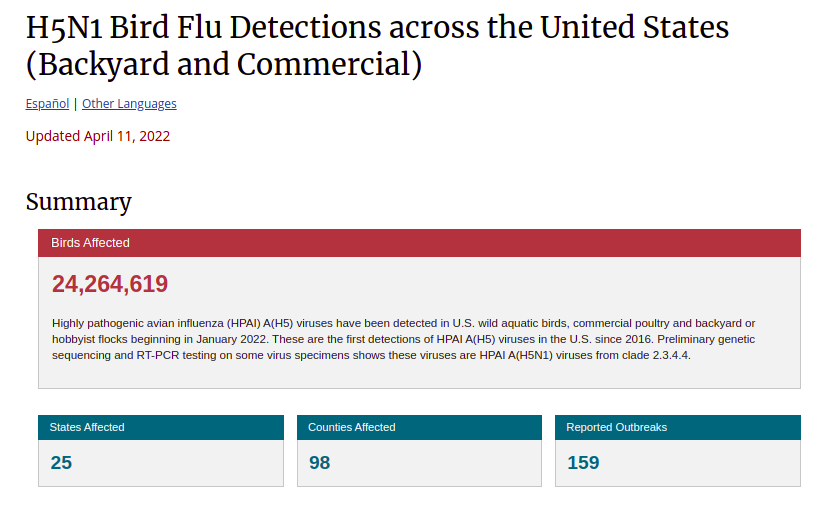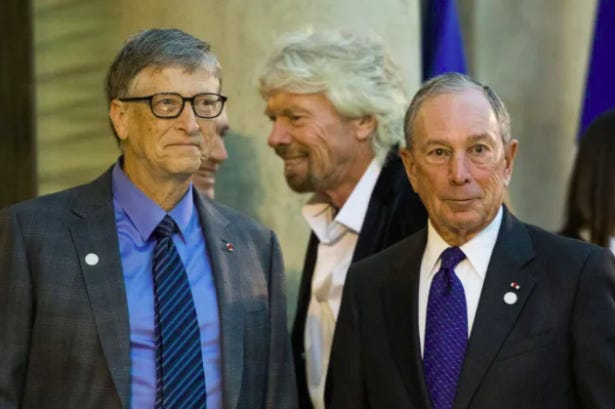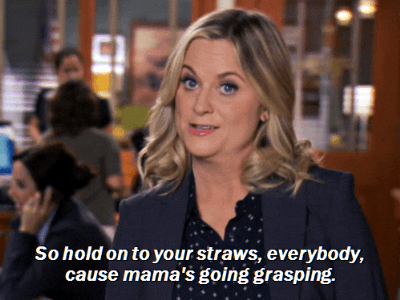I care for a few dozen backyard chickens, so for me, this avian flu hype is worth paying attention to, despite the rather overt fear-mongering tone in which it’s often reported or discussed.
For the uninitiated, HPAI (Highly Pathogenic Avian Influenza) is a bird-adopted strain of the Influenza Type A virus. The influenza virus can cause illnesses in a wide range of animals, and has many different subtypes, which often are species specific but do occasionally cross-over between species, fueling a constant evolution of all subtypes. This type of avian influenza, similar to human influenza, evolves throughout the year, modifying it’s genetics to optimize survival while maximizing infection into hosts.
In the United States, as of April 11th 2022, there have been 159 identified outbreaks, and as a result, over 24 million birds have been “depopulated” in efforts to suppress the particular spread of HPAI H5N1. These outbreaks are detected on both backyard & commercial scale operations, ranging in size of a flock of 5 birds to a flock of over 5 million birds. Thus, a single positive result has the potential to trigger the “depopulation” of someone’s entire flock, whether it’s a handful of backyard hens, or millions of birds living and working in the equivalent of sweatshop conditions.
Worth noting, these “depopulation” efforts are in direct response to positive readings from PCR tests, which have numerous issues, and have been repeatedly declared (including by the inventor) to be inappropriate for use as a diagnostic tool. Thus, many of these “depopulations” are quite possibly knee-jerk reactions to eliminate something that may not even exist.
There doesn’t appear to be anything other than anecdotal accounts that would support the notion that backyard flocks are less susceptible to contracting this virus. For my flock, I have set up a large pen of around 8,000 square ft with netting up around the perimeter, encompassing a somewhat wooded area, and in warmer months the chickens are free to roost in the trees, fresh air abundant and with ample spacing. During the early spring and fall they free roam around the property, helping control the bug population. The combination of the free range & open nature of the pen allows for wildlife transmission occurrences, but common sense suggests this same open air concept gives the birds’ respiratory system better overall vitality, and more potential to combat pathogens.
I’d like to think providing my chickens with optimal (or at least more natural) living conditions should warrant an opportunity for them to fight off any possible infections, and yet there is very little clarity on the issue, and I fear even less choice in the matter. If I were to suspect my birds have contracted this virus, would I be required to report it, and in doing so, risk a mandated mass-culling?
The potential for H5N1 to crossover and become a serious health concern for humans is very real, yet theoretically extremely slim, though it’s impossible to get an accurate and current read from all the (lack of) info available. And I believe I’m not alone when I declare that trust in these institutions has long since eroded.
So, I will the use the time-tested approach of pattern recognition to try to understand what may come next, if there is a need for concern, and sadly, are we being deceived along the way?
A lil historical background:
H5N1 crossover in humans has been recorded as far back as 1997, and while there were no human to human transmissions recorded, cases had an extremely high fatality rate, and there was a sense of urgency to find a solution before a full leap to humans occurred. One tool used to tackle this problem was (and continues to be) Gain of Function (GoF) research. In the United States, this research was paused in 2014, funding resumed in 2017, and research fully restarted again 2019.
This gain of function research is varied across the board, covers different pathogens, and being done in numerous countries, but all have the same thing in common: Pathogens are intentionally manipulated to create something that would have otherwise not existed, and the research is justified by the cited need to create a solution for this self-created problem, which would have otherwise not existed. The irony is a little too rich, as this issue is now applied directly to chickens and their eggs.
In this particular study, H5N1 was modified to crossover into ferrets, to better understand what the risk might be if this highly pathogenic disease were to infect mammals, with a preconceived estimate of 50% mortality (according to Fauci, so take that as you will). To make this clear = the goal of this study was to create a highly transmissible virus that has the capabilities to kill 1 out of every 2 people who becomes infected.
A massive amount of funding has been (and continues to be) distributed to support this type of research, and one can only imagine that the rhetoric used throughout the SARS-CoV-2 pandemic is leading to increased funding. We may be in the midst of the most dangerous feedback loop ever created.
Back in 2011, this research was already highly controversial, but now that there has been a global incident that likely stemmed from this type of research, one would expect a more cautious approach to be taken. These are the crossroads we are at, which will likely never be articulated accurately to the public. It most likely (to me) explains the massive suppression of the lab leak hypothesis earlier in the pandemic, as all gain of function research would be justifiably jeopardized from public outcry, should that be the true origin of the novel SARS-CoV-2 virus. And now as censorship continues to accelerate in many places, I deeply fear for our potential for course correction.
FACTORY FARMING vs BACKYARD FLOCKS
There is a legitimate argument to be made for concentrated livestock operations contributing to the evolutionary selection pressure for viruses to become more pathogenic.
These concentrated feed lots vaccinate regularly, which paradoxically fuels “hotter” viruses over time (as observed in the often cited Marek’s Disease).
Vaccination doesn’t necessarily stop transmission or prevent infection, and viruses will continue to evolve in fully vaccinated flocks, with different selective pressure placed on these viruses, which adapt in an attempt to survive. Over time these viruses become more pathogenic, or “hotter”, new vaccine formulas are created to adapt, and the cycle continues, only to further intensify as time goes on.
Our modern system of agriculture has countless issues which need addressing, but the threat of disease is one which can literally wipe out the meat industry, should an outbreak go unchecked. Hence, this truly may become an all-out attempt to protect the meat industry from it’s own bloated implosion.
The research surrounding these viruses becomes more intriguing as we look into the funding of research, and while it becomes rather speculative, it’s all based on current observable data and info. The goal is to identify patterns, and as time wears on, consider the plausibility of hypothetical ulterior motives.
Following the money, this research is funded by a wide range of actors, but some popular names make the list, and many will not be surprised to learn that the Bill and Melinda Gates foundation is behind funding what was dubbed “probably one of the most dangerous viruses you can make”.
Some other Gates dots worthy of connecting:
Bill Gates is well known as being a proponent of vaccines, especially in developing regions of the world.
Bill Gates is also one of the biggest public proponents for alternative meats.
Bill Gates also happens to be the biggest individual landowner for farmland in the United States.
I’m not trying to paint Bill Gates as the bogeyman; the internet has already done a great job of that, and it’s clear that there are many different agendas being played out. I’m simply attempting to identify one of the major players in this game, who has his hands in many different industries, pulling strings, and smiling snidely along the way.
Other things worth consideration:
It’s quite possible that while GoF experiments were banned in the United States in 2014, they merely shifted operations to countries like Ukraine, which may or may not contain biolabs funded by the Pentagon, and may or may not be conducting active research on the H5N1 virus adapted for cross-over into mammals.
It’ll be awhile til the dust settles on all this, but it’s potential relevance is important to revisit again down the road.
The situation in Shanghai is reaching a whole new level of dystopia every day, and China’s “COVID Zero Policy” stems from the same philosophy that is being applied towards containing HPAI.
Relevant to this topic of bird depopulations, China is claiming that there have been no recorded deaths so far within this city of 26 million people. From an outsider’s lens, this means that the devastating lockdowns may quite literally be for nothing, as the COVID Zero policy is primarily meant to contain and prevent further spread. Preventing deaths is not the first priority; containment is.
H5N1 in the U.S. is inverted to this, as 24+ million birds have been killed from our mitigation measures, all the while, it is completely possible that not one of those birds died from or even contracted infection.
All of this is immensely important because we are likely entering a brave new era heavily governed by bio-security mandates and centralized paradigms of authority.
If there becomes a push for outright banning backyard poultry, all of the issues discussed here suddenly become critical for exploration, and so this post is meant to be a primer for what I expect to become an uphill battle concerning the legality of unlicensed backyard livestock operations. The drastic “depopulation” measures are currently affecting commercial and home operations alike, but I want to make it very clear = this is all in the name of maintaining our current meat supply system, which is predominantly factory farming and concentrated feed lots.
One could say there is a bit of a war going on between the meat industry and the alternative meat/biotech industry, but one could also point to collusion amongst the powerful plays in both of these industries, so it’s difficult to say how we should proceed collectively (pretending that we are in charge of our own destinies.)
Regenerative agriculture is potentially a savior of sorts from the many global problems ailing our planet, with responsible agricultural practices yielding much better results for all aspects of environmental welfare and atmosphere quality. There’s a range of opinions on how this method should practiced, and whether or not it should be standardized, which sparks a danger of the concept being weaponized for profits (a long standing pattern amongst humans). The fact that even the World Economic Forum acknowledges it’s benefits makes me pause for concern of a hostile corporate takeover of the movement.
There are many different views on if this method can be implemented on a scale to feed the entire planet. Regardless, it seems that unless something like world peace suddenly happens, and the runaway inequality and systemic issues are addressed, there will be food shortages on the horizon, particularly within a meat industry that is rampantly depopulating it’s own stock.
So how do we solve this issue? Cutting back on meat (even just temporarily) is an option, but imagining people reacting to that solution is a little too comical for me to consider at the moment.
A potential compromise I envision down the line is urban areas (densely populated) in general subscribe to the concept of alternative meats, while rural areas rely primarily on regenerative agriculture for traditional meat and food sustenance. This mirrors the synthetic vs. natural aspect of our corresponding lifestyles, and more importantly, preserves people’s autonomy and freedom of choice.
This current system is clearly unsustainable and cannot be dismantled overnight, yet going to extreme measures of mass-culling is not a viable long term solution. It’s more of a genocidal bandage to a self-imposed, long-infected wound.
It’s weird, it’s almost like the industrialized meat industry is a sentient entity, recognizing it’s own mortality, and realizing that time is running out. We are left to observe a reactionary kicking the can of life down the road, and desperately grasping at the imaginary straws of immortality.





